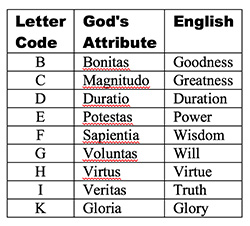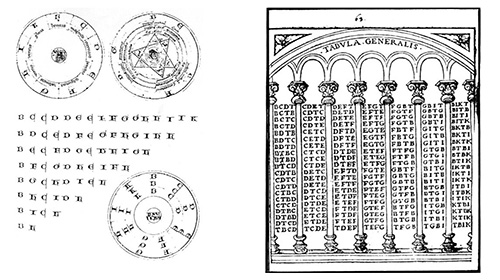Bl. Raymond Llull and the World's First Computer

Very few people in history can equal Bl. Raymond Llull's (AD 1235-1315) intelligence, learning, wisdom and ingenuity. Due to his prodigious learning, he's referred to as Doctor Illuminatus, (Latin: the "Illuminated Doctor.") But despite all of the many gifts and charisms he possessed, all he wanted was to love God, study, and convert nonbelievers to Christ.
He was born on Mallorca into a rich family and enjoyed the carefree life of a courtier to King James of Aragon until AD 1265, when Llull received a vision of Christ crucified. He repented of his former life and gave up his black magic and occultist studies, sorrowful for his formerly sinful ways, and became a Secular Franciscan. He thus dedicated himself to spreading the Gospel and evangelizing Muslims.
He wrote numerous religious treatises and made several missions to northern Africa, trying to convert the Muslim infidels of Tunis to the Church. He hoped that the three monotheistic faiths—Judaism, Christianity and Islam—would unite to defeat Asian invaders that were then threatening Europe and the Middle East. He successfully pressed kings and popes to start university departments throughout Christendom where missionaries could learn Arabic to better evangelize Muslims.
Raymond was good friends with St. Raymond of Peñafort and Bl. Duns Scotus. The later nicknamed him "Doctor Illuminatus" due to his prodigious knowledge and wisdom. He wrote over 300 books and treatises in Latin, Arabic and Catalan on the sciences, politics, sociology, theology, logic and philosophy. Among these books was the first major work of Catalan literature which was Europe's first novel—the romantic novel Blanquerna. He also wrote poetry. He also wrote Ars notandi, Ars eleccionis and Alia ars eleccionis, in which he anticipated by several centuries prominent work on elections theory, a number of treatises on chemistry, botany, astronomy and other topics. Llull was also known as an alchemist but this is because at the time, alchemy was the precursor of the modern analytical science of chemistry. But even if he was an alchemist, he reinterpreted that protoscience in thoroughly Christian-based concepts.
In AD 1305, Bl. Raymond Llull published his Ars Generalis Ultima or Ars Magna ("The Ultimate General Art,") which was originally intended as a debating tool to convert Muslim invaders in Spain, Portugal and northern Africa to the Church through ineluctable logic and all-encompassing reason.
Raymond also created a machine based on the astrolabe to help apologists and field missionaries. Regardless of what point a Muslim could bring up, Llull's debating machine found the correct counterpoint. Llull invented many such machines for this purpose.
Llull's computational ideas were developed further in the 15th century by St. Nicolas of Cusa, Giordano Bruno in the 16th century and by Athanasius Kircher and Gottfried Leibniz in the 17th century. Llull's work laid the foundation of the analytical study of logic and information science. Bruno used the rotating figures of the Llullist system as instruments of a system of artificial memory, and attempted to apply Llullian mnemotechnics to different modes of rhetorical discourse. Llull is thus the founder of computation theory.
In AD 1314, at the age of 78, Raymond traveled for the third time to North Africa, where he stood in the Bougie marketplace to evangelize Muslims. The infuriated crowd stoned and nearly killed him. Genovese merchants took him back to Mallorca where he died the following year from the attack he suffered.
One of Llull's most important contributions to Christianity and humanity in general was his Ars Magna— a general system for the interpretation of visible and invisible reality.
Let that sink in for a moment…
…visible and invisible reality…
This machine made use of semi-mechanical techniques, symbolic notation and combinatorial diagrams. It was the foundation of his apologetics and provided a single methodological basis for all fields of knowledge in the 13th century, from theology and philosophy to the natural sciences. By adjusting the relative relationship of different concepts as they were brought up while evangelizing, new paths of insight and thought were created.
Llull's memory device was the world's first analog computer and was made of vellum. Modern people would refer to his invention as a volvelle.
One is given pause to think what Bl. Raymond could have done if he could get his hands on some transistors or an integrated circuit.
Llull's radical innovation was the first physical tool ever used by logicians―experts in logic. It allowed the user to combine seemingly disparate and incongruous aspects of thinking and language which he connected by intricate geometrical figures. Using a precisely calibrated and defined framework of rules, Bl. Raymond tried to produce all the possible logical declarations, represented by a chain of letters, of which the human mind could imagine.
His machine consisted of three circular paper disks fixed on an axis on which they turned. The letters B to K were on the outside of the paper disks. When the circles were turned, all possible combinations of these letters are produced.
Each letter, from B to K, is written upon the paper-circle known as the Prima Figura represented not only itself but also several strictly defined and placed meanings. By writing the letters from B to K as key-terms heading a table, a series of different sentences can be easily constructed.

The next strictly defined table of words can be produced on the next smaller circle which Bl. Raymond called the Secunda Figura. It was here where he listed categories and through relations.
With the careful manipulation of the wheels of his volvelle, Llull's mechanical construct allowed each concept to be combined with all other concepts limited only by how each of the individual tables were constructed. For example, in Llull's original construct's Prima Figura, he listed nine words describing the attributes of God. Combined with a separate table of nine questions, he was able to construct the skeleton of the proofs of God's Existence thus allowing his machine to show all possible statements and declarations about God.
Llull's paired his construct with what he called the Tabula Generalis. Whatever strings of letters produced by the volvelle were then looked up on the Tabula Generalis. The series of letters are actually a hidden code. These columns of letters represented the totality of human wisdom―this lullistic alphabet contained a rich potential of meanings. This two tools combined allowed each letter to represent an unlimited number of words of unlimited intellectual fields.

Bl. Raymond is the first person to make logical deductions mechanically rather than mentally. His volvelle is thus the world's first analog computer which allowed him to simulate, synthesize and produce human knowledge using artificial means. This was the first step to a thinking machine. In fact, his Ars Magna is also referred to as a machina de pensar. (Catalan: "thinking machine."
Bl. Raymond was a martyr, mystic, reformed sinner, secular Franciscan, scholar, logician, theologian, scientist, inventor, mechanist, engineer, mathematician, philosopher, political theoretician, poet, novelist, computer architect and missionary to Muslims.
He single-handedly laid down the foundations of computer science, elections theory, modern chemistry and computation theory. There are Renaissance men and then there's Bl. Raymond Llull.
Bl. Raymond was a Renaissance man before the Renaissance ever started. He was a Renaissance man three hundred years before Michelangelo Buonarroti—another Catholic, who personified the term—was even born.
When this exhausted Christian stood before the Lord of All at his Particular Judgment, even Jesus must have smiled as he looked over Llull's resume.
Consider now the computer upon which you are reading this particularly well-written, delightful, pithy and informative article. If it were not for this 13th century saint, you would never, ever, ever have had a computer crash on you or lose an important presentation you needed for work or have to suffer through all of those supremely unnecessary photos of your neighbors' vacation in Bora Bora or Baden Baden or even Hoboken Hoboken.
But, for all the problems that computers have caused us, and, perhaps, one day, computers will be our servants rather than the other way around, we can at least rejoice in the fact that it, and all computers in general was created by a faith-filled Catholic man who is on his way to sainthood.
Thank you, Bl. Raymond! You've done humanity a great favor!













